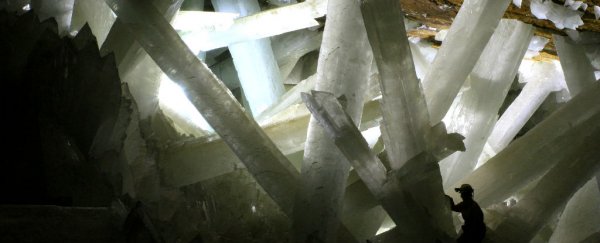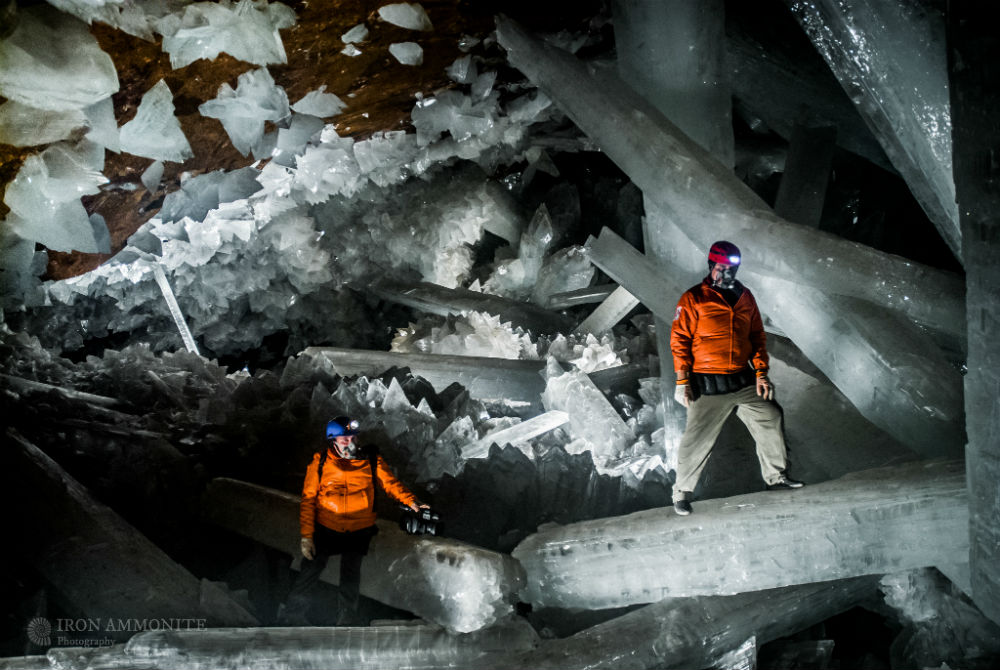Strange microbes have been found inside the massive, subterranean crystals of Mexico's Naica Mine, and researchers suspect they've been living there for up to 50,000 years.
The ancient creatures appear to have been dormant for thousands of years, surviving in tiny pockets of liquid within the crystal structures. Now, scientists have managed to extract them - and wake them up.
"These organisms are so extraordinary," astrobiologist Penelope Boston, director of the NASA Astrobiology Institute, said on Friday at the annual meeting of the American Association for the Advancement of Science (AAAS) in Boston.
The Cave of Crystals in Mexico's Naica Mine might look incredibly beautiful, but it's one of the most inhospitable places on Earth, with temperatures ranging from 45 to 65°C (113 to 149°F), and humidity levels hitting more than 99 percent.
Not only are temperatures hellishly high, but the environment is also oppressively acidic, and confined to pitch-black darkness some 300 metres (1,000 feet) below the surface.
In lieu of any sunlight, microbes inside the cave can't photosynthesise - instead, they perform chemosynthesis using minerals like iron and sulphur in the giant gypsum crystals, some of which stretch 11 metres (36 feet) long, and have been dated to half a million years old.
Researchers have previously found life living inside the walls of the cavern and nearby the crystals - a 2013 expedition to Naica reported the discovery of creatures thriving in the hot, saline springs of the complex cave system.
But when Boston and her team extracted liquid from the tiny gaps inside the crystals and sent them off to be analysed, they realised that not only was there life inside, but it was unlike anything they'd seen in the scientific record.
They suspect the creatures had been living inside their crystal castles for somewhere between 10,000 and 50,000 years, and while their bodies had mostly shut down, they were still very much alive.
"Other people have made longer-term claims for the antiquity of organisms that were still alive, but in this case these organisms are all very extraordinary - they are not very closely related to anything in the known genetic databases," Boston told Jonathan Amos at BBC News.
What's perhaps most extraordinary about the find is that the researchers were able to 'revive' some of the microbes, and grow cultures from them in the lab.
"Much to my surprise we got things to grow," Boston told Sarah Knapton at The Telegraph. "It was laborious. We lost some of them - that's just the game. They've got needs we can't fulfil."
At this point, we should be clear that the discovery has yet to be published in a peer-reviewed journal, so until other scientists have had a chance to examine the methodology and findings, we can't consider the discovery be definitive just yet.
The team will also need to convince the scientific community that the findings aren't the result of contamination - these microbes are invisible to the naked eye, which means it's possible that they attached themselves to the drilling equipment and made it look like they came from inside the crystals.
"I think that the presence of microbes trapped within fluid inclusions in Naica crystals is in principle possible," Purificación López-García from the French National Centre for Scientific Research, who was part of the 2013 study that found life in the cave springs, told National Geographic.
"[But] contamination during drilling with microorganisms attached to the surface of these crystals or living in tiny fractures constitutes a very serious risk," she says. I am very skeptical about the veracity of this finding until I see the evidence."
That said, microbiologist Brent Christner from the University of Florida in Gainesville, who was also not involved in the research, thinks the claim isn't as far-fetched as López-García is making it out to be, based on what previous studies have managed with similarly ancient microbes.
"[R]eviving microbes from samples of 10,000 to 50,000 years is not that outlandish based on previous reports of microbial resuscitations in geological materials hundreds of thousands to millions of years old," he told National Geographic.
For their part, Boston and her team say they took every precaution to make sure their gear was sterilised, and cite the fact that the creatures they found inside the crystals were similar, but not identical to those living elsewhere in the cave as evidence to support their claims.
"We have also done genetic work and cultured the cave organisms that are alive now and exposed, and we see that some of those microbes are similar but not identical to those in the fluid inclusions," she said.
Only time will tell if the results will bear out once they're published for all to see, but if they are confirmed, it's just further proof of the incredible hardiness of life on Earth, and points to what's possible out there in the extreme conditions of space.

